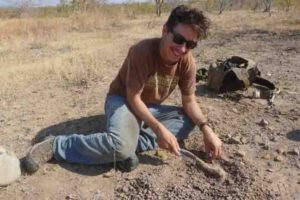
The end-Permian mass extinction (EPME) occurred about 250 million years ago and represents the Earth’s most catastrophic extinction event. Up to 96% of marine species and 70% of terrestrial vertebrate species went extinct, opening up habitats for the evolution of dinosaurs and mammals. A new study, being presented at the 77th Annual Society of Vertebrate Paleontology meeting in Calgary, Alberta, compares the recovery of land-dwelling vertebrates from different localities in the southern portion of the super continent Pangaea. Presenter Brandon Peecook explains, “By studying the different ecosystems that assembled after the largest mass extinction in Earth history we can get a sense of the ecological and geographic context in which the earliest members of important lineages (like mammals and dinosaurs) first appeared.”
One of the most studied localities for the extinction of land-dwelling vertebrates during the EPME is the Karoo Basin of South Africa. This geographic area has a continuous record across this massive extinction event and the recovery period. To compare the recovery of vertebrates from different localities, Peecook studied other fossil assemblages from Zambia and Tanzania. “One would expect that animal communities on Pangea would be similar, but intriguingly contemporaneous ecosystems in the wake of the end-Permian mass extinction are starkly different from one another,” Peecook said.
The recovery of organisms after the EPME is extremely important to understand how resilient both marine and terrestrial life is on Earth. The patterns of mass extinction events and subsequent recoveries are among the most powerful contributions of paleontology to evolutionary theory. Mass extinctions are recognized as global events; however, studies of single localities or regions deepen our understanding of extinction and recovery by revealing heterogeneity in timing and process.
Peecock found the recovery of organisms in the Middle Triassic regions studied are very dissimilar. Carnivores and archosaurs are diverse and abundant in Zambia and Tanzania, but relatively uncommon or absent in South Africa. Ecological diversity levels of the Zambian and Tanzanian assemblages are equal to or exceed Permian ecological diversities, whereas those of the Karoo Basin are less. Peecook stated, ” The fossil record is our best source of data on the effects of massive disturbances on natural ecosystems, and their subsequent recoveries. We can’t perform
Note: The above post is reprinted from materials provided by Society of Vertebrate Paleontology.










